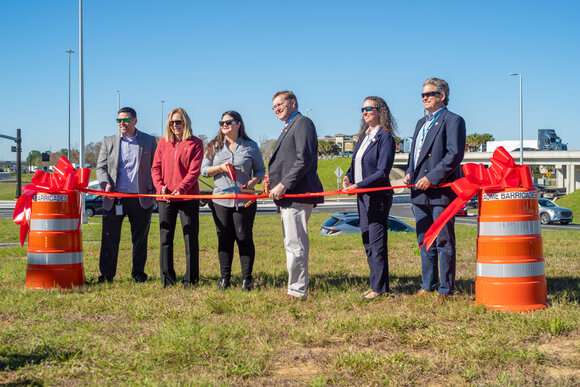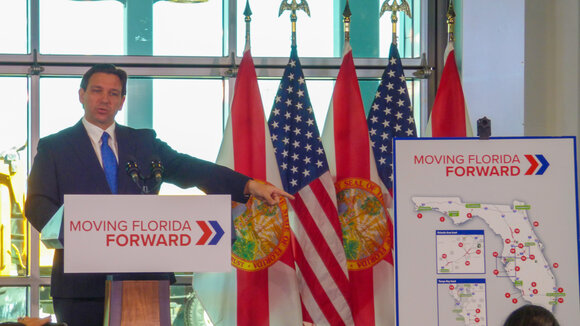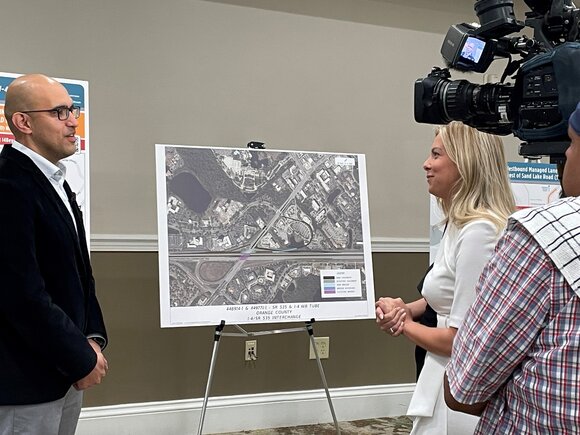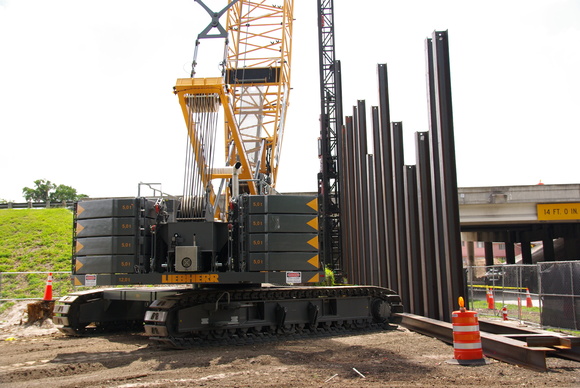The Diverging Diamond Interchange Project at
ChampionsGate is
Now Completed
After years of planning and construction work, the
diverging diamond interchange (DDI) at Interstate 4
(I-4) and County Road (C.R.) 532 has been completed.
This is the first interchange of its kind in the
Orlando area.
Osceola County Commissioner Peggy Choudhry, FDOT
District Five Secretary John E. Tyler, P.E., and
FDOT District Five Safety Administrator Loreen Bobo,
P.E. presided over a special ribbon-cutting ceremony
on February 13 to commemorate the project’s
completion. Guests in attendance were invited to
take a tour of the new pedestrian and bike lanes
along C.R. 532, which gave the interchange dedicated
walking and cycling routes for the first time.
“As we celebrate today the completion of this
interchange, we’re excited with what’s been
accomplished, but we’re also looking forward to the
next improvements we can bring with the help of our
great local partners in Osceola County,” Tyler said.
The innovative project was designed to improve
safety and mobility in the ChampionsGate area. In
addition to the new DDI, improvements include
widening the exit and entrance ramps to I-4,
eliminating the left turn from southbound Goodman
Road to C.R. 532, adding a wrong way vehicle
detection system (WWVDS), and repaving throughout
the area.
In the new DDI, motorists approaching the
interchange on C.R. 532 switch to the left side of
the road at a traffic signal. After passing under
the interstate, they return to the right side at
another traffic signal.
A DDI improves safety and mobility in several ways.
First, it eliminates the need for left turns across
oncoming traffic. Compared to a conventional
interchange, a DDI has fewer conflict points, or
places where vehicles cross paths, reducing the
potential for collisions. Furthermore, it reduces
the number of traffic signal phases, allowing more
cars to travel through the interchange.
More DDIs are coming soon to improve the efficiency
of other I-4 interchanges, including the ongoing
Daryl Carter Parkway project and the upcoming
improvements at Sand Lake Road.
For more information on DDIs, visit
i4beyond.com/DDI.
|
|
Governor DeSantis Announces Plan Aimed at
Expediting I-4 Projects
On Monday, January 30, Florida Governor Ron DeSantis
announced special proposed funding that will
expedite several congestion relief projects across
Florida. The announcement took place at a press
conference in Polk County at the SunTrax facility, a
testing site for autonomous and transit vehicles.
The goal of the proposed funding is to ease
congestion while providing the necessary expansion
to keep pace with Florida’s rapid growth.
The initiative, titled “Moving Florida Forward,”
aims to bring improvements to Interstate 4 (I-4),
I-275, and I-75 over the next four years. For the
I-4 Beyond the Ultimate program, proposed funding
totals approximately $2 billion. The proposed
funding would kick start major I-4 improvements to
the I-4 corridor in Osceola County. The Florida
Department of Transportation (FDOT) plans to
reconstruct I-4 to accommodate three general use
lanes, auxiliary lanes, and two express lanes lanes
in the eastbound and westbound directions from west
of County Road (C.R.) 532 / ChampionsGate to east of
C.R. 522 / Osceola Parkway. Reconstruction of
existing interchanges is also part of this work.
Additionally, the proposed funding would reconstruct
I-4 to accommodate three general use lanes,
auxiliary lanes, and two express lanes in the
eastbound and westbound directions from west of U.S.
27 to west of County Road (C.R.) 532 /
ChampionsGate. A third project in the Osceola County
area was also proposed with the “Moving Florida
Forward” initiative. A Florida’s Turnpike project,
Poinciana Parkway Extension Connector, proposes to
extend about 4 miles from Osceola-Polk County Line
Road/C.R. 532 to north of the I-4 at State Road 429
interchange in Osceola and Polk Counties.
The Florida Legislature will need to approve the
program. If approved, public meetings for proposed
I-4 Beyond the Ultimate improvements in the Osceola
County corridor would be scheduled as soon as summer
2023. Statewide, the plan fast tracks approximately
20 crucial projects that would have ordinarily taken
up to 20 years to complete.
Learn more about the Moving Florida Forward
Initiative at
fdot.gov/movingfloridaforward.
|
|
FDOT Public Meeting Previews Improvements at I-4
and S.R. 535 Interchange
Florida residents attended the Florida Department of
Transportation’s (FDOT’s) hybrid public meeting to
learn about upcoming improvements in Orange County
at the interchange of Interstate 4 (I-4) and
Apopka-Vineland Road (State Road (S.R.) 535). Some
attendees visited the open house in person on
February 8 at the Floridays Resort Orlando, while
others attended virtually through GoToWebinar.
The purpose of this project is to partially
reconstruct the interchange to enhance safety and
improve access to and from westbound I-4 and to add
capacity to I-4. The public meeting was held to
present information and receive community feedback.
The meeting provided area residents, pedestrians,
cyclists, and motorists with details about the
proposed improvements as well as a potential
timeline for construction. Design engineers answered
questions and explained the proposed improvements
with the help of design plans, large display maps,
video, and informational handouts. The public also
had the opportunity to submit questions and comments
about the project, which will be part of the public
record.
For more information about these improvements or to
review materials from the public meeting,
visit the meeting web page
or
CFLRoads.com.
|
|
Employee Spotlight: Nicole Colón, Assistant
Project Administrator/Contract Support
Specialist
Nicole Colón is an assistant project
administrator/contract support specialist on the
ongoing Interstate 4 (I-4) capacity construction
projects in Osceola County. Colón’s job as part of
the construction engineering and inspection team
involves her being responsible for the project’s
office-related duties and paperwork, helping the
project to run smoothly.
“I handle most of the money, the estimates, the
finances. I write the work orders and the
supplemental agreements,” Colón said of her
day-to-day job duties. “I track all of the materials
and I try to help our inspectors in any way they
need.”
The current I-4 capacity construction projects in
Osceola County include Project No. 444329-1, which
is adding new eastbound and westbound I-4 auxiliary
lanes — one in each direction — between the ramps of
State Road (S.R.) 429 and County Road (C.R.) 532, as
well as an auxiliary lane on northbound S.R. 429
between I-4 and Sinclair Road. The project includes
milling and resurfacing S.R. 429 between I-4 and
Sinclair Road. Project No. 443958-1 consists of
milling and resurfacing eastbound and westbound I-4
from the Polk/Osceola County line to west of S.R.
417.
“I really like the fact that I don’t have to be in
one place for a long length of time. I love the fact
that we come in and we are on a project for a couple
of years,” Colón said. “We give the public a product
and then we can move on to our next one, and it’s a
whole new set of learning opportunities.”
Colón knows the importance of having in-depth
knowledge of all the project’s components.
“I don’t stop learning,” said Colón. “I am
constantly asking questions.”
Colón took the initiative to become certified in
multiple construction training and qualification
program (CTQP) certifications, including asphalt
paving, earthwork construction inspection, final
estimates, and quality control management.
“I feel like it helps me do my job better and gives
a better understanding of what I need from the
inspectors, and what I need from the QC side of
everything,” Colón said of her CTQP certifications.
Colón acquired expert knowledge during her 15 years
in the industry. She was always interested in the
trade, majoring in civil engineering at the
University of Central Florida prior to joining the
U.S. Navy. As a Florida native growing up in Winter
Park, Colón moved back to Central Florida after her
time in the Navy to begin her career. Prior to her
current role, Colón worked as a public information
officer and was the co-chairperson for Central
Florida Construction Career Days, a nonprofit
organization introducing high school students to the
roadway construction industry.
Outside of work, Colón stays busy attending her
youngest daughter’s soccer games and
horseback-riding activities. When she isn’t busy
driving her youngest child to her endless
activities, Colón enjoys traveling and photography.
With her youngest now old enough to travel more,
Colón said, “I love going out there and just
wandering and taking pictures and finding new
places.”
The current I-4 capacity construction projects in
Osceola County broke ground in November 2021 and are
anticipated to be completed in early 2024.
|
|
Pile Driving Begins at Daryl Carter Parkway
Improvement Project
Every major structure built as part of the I-4
Beyond the Ultimate project requires a solid
foundation to ensure it will last for years to come.
A key part of these foundations is underground
pillars made of concrete or steel, otherwise known
as "piles." Piles often need to be placed more than
100 feet underground to provide safe, stable
foundations for bridges and overpasses.
Pile driving is typically done in two ways. The
first involves “vibrating” the piles into the
ground. In the second method, if the soil is soft
and loose, piles can be shaken into the ground,
rather than driven, using a hydraulic or
diesel-powered hammer. Vibratory pile is also
effective at installing sheet pile, which supports
wall structures.
However, even when using the vibratory method, it
may be necessary to use a pile-driving hammer to set
the piles in place at the end of the process. The
impact of a hammer to the top of the pile drives the
steel or concrete pile through dense underground
layers to the required design elevation.
If you reside near pile driving activity you may
hear the pile-driving hammer and sometimes notice
ground vibration. The Florida Department of
Transportation (FDOT) Standard Specification 108
details the contractor’s responsibility to monitor
vibration and settlement. If excessive vibration is
encountered, countermeasures will be implemented.
Most pile driving takes place during the day to
minimize impact to nearby residents. To mitigate
disturbances while still ensuring accuracy and
stability, inspectors utilize tools such as
vibration sensors to carefully monitor levels of
vibration, along with the number of blows it takes
to reach a certain level. Vibration levels can be
affected by the type of soil, the building
structure, and a person’s location. Noise levels may
fluctuate due to proximity to the pile driving and
the type of structure the person is inside.
Recently, pile driving started in mid-January near
the improvement project that is transforming the
Daryl Carter Parkway overpass into a Diverging
Diamond Interchange (DDI) as part of the I-4 Beyond
the Ultimate project. Nearby residents and
businesses were informed of the pile driving in
advance to prepare them for the process.
If you have any questions or concerns regarding pile
driving activity, please
contact us.
|
|
Video: Upcoming Improvements at Interstate 4 and
U.S. 17-92
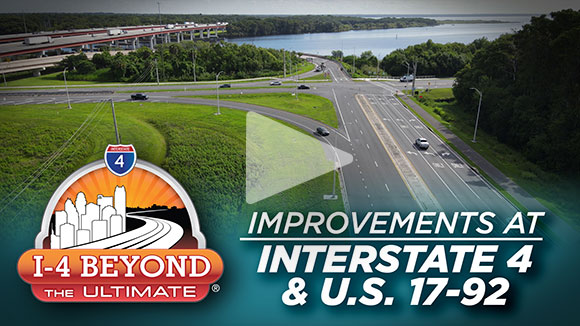
|
|
Click on image above to view video.
|
|
|
The Florida Department of Transportation (FDOT) will
soon begin work on safety and operational
improvements at the Interstate 4 (I-4) and U.S.
17-92 interchange in Seminole County. This video
details the work that will be part of the project.
|
|
QUIZ: Hit-and-Run Awareness Month

|
|
Take our quiz
to test your knowledge of Hit-and-Run
Awareness Month.
|
|
|
February is Hit-and-Run Awareness Month. The Florida
Department of Highway Safety and Motor Vehicles
(FLHSMV) urges drivers involved in a crash to stay
at the scene.
Nearly 25 percent of all Florida crashes involve a
hit-and-run. The Stay at the Scene campaign aims to
bring down the number of hit-and-run crashes by
informing drivers on what to do if they’re involved
in a crash and the consequences they face if they
choose to leave the scene.
Take this quiz to test your knowledge of Hit-and-Run
Awareness Month.
|
|
|


